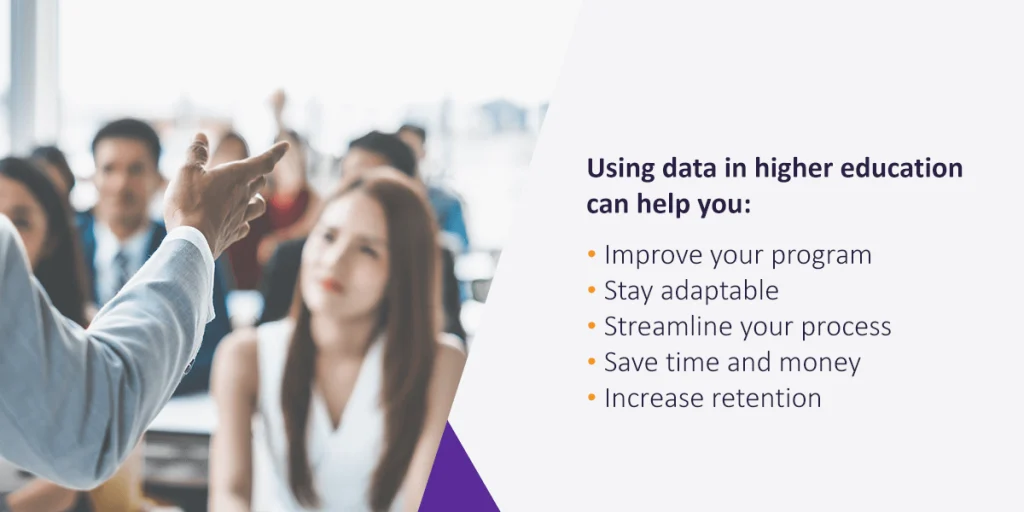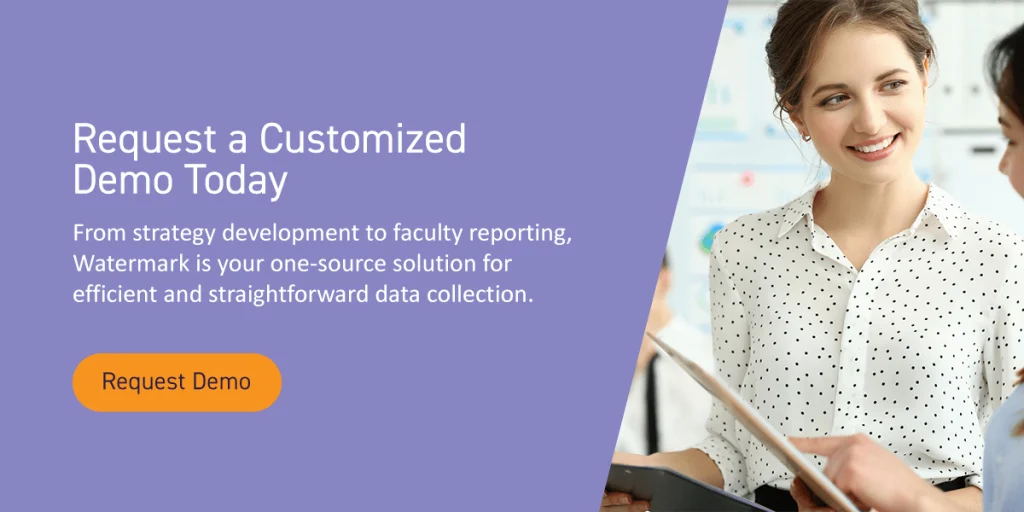Personalized interactions are essential — and an expectation — in our daily lives. Many consumers are more loyal to companies that recognize, remember, and cater to their unique needs. From healthcare to retail, many industries use digital platforms to consistently engage users and securely collect data.
In an increasingly technology-driven age, personalization in higher education is more important than ever. Students need accessible, individualized solutions, and you can deliver those through data-informed decision-making. Effective data management can help you make more beneficial choices, enhance your students’ academic journey, and set them up for lifelong success. Learn how to apply big data insights to higher ed and create a safer, more curated experience for your students.
Adapting to data-driven decision-making in higher education
COVID-19 accelerated the demand for tailored, engaging education. With the unprecedented rapid shift to online learning, higher education institutions must adapt data-driven decision-making into their strategy. Data collection is a critical component of education personalization, better student outcomes, and institutional growth.
Data-informed decision-making requires dedication, transparency, and respect. Most users will exchange data for more personalization, and accommodating this desire can improve the higher ed experience. How do you make the switch? Follow these tips for a smooth transition:
- Commit: Whatever your approach, ensure it aligns with what your students and faculty value. Your goals should reflect your higher education institution’s unique mission, culture, and abilities. To create measurable and transformative objectives, you must commit to achieving real, meaningful results.
- Invest: A data-driven strategy involves more than the proper technology. If you want to tackle more challenging goals like graduation or retention rates, you’ll need broader strategies, more data, and more resources. You also need data literacy skills to use information effectively. However, data-informed decision-making in education often pays for itself with increased revenue and long-term reputational value.
- Be responsible: Your students and faculty trust you to protect any sensitive data. Couple your analytic tools with extensive training programs to raise awareness and encourage transparent and appropriate data usage.
- Collaborate: Personalizing education is a team effort. Work closely with other institutional leaders and give your faculty and staff the resources they need to succeed and develop empowering curriculum.
- Manage your expectations: Everyone is different and will take time to adjust to your new methodology. Be patient, aim high, and embrace any setbacks or mistakes. Even if you have to take detours, you’ll come out a better leader and decision-maker in the end.
- Act: Each semester impacts thousands of students, faculty, and staff. Whether you have a solution in mind or need to address a pressing issue, your actions should be quick, decisive, and collaborative.
Personalization in Higher Education
Higher education faces many challenges, from low engagement to high dropout rates. In a traditional “one-size-fits-all” environment, almost one-third of first-year students drop out before their sophomore year. The personalization of education offers a more immersive alternative that allows students to pursue their passions, learn in the way they want, and chart their own courses. By catering to students’ interests, goals, and capabilities, an individualized approach offers numerous institutional benefits:
- Encourage students to be more autonomous and proactive.
- Provide multiple formats and accessibility and delivery methods to accommodate any learning style.
- Keep students engaged and motivated so they’re more likely to complete their education.
- Identify learning gaps early to improve student outcomes and achieve institutional goals.
- Help instructors develop more effective, customized teaching methods.
Because students and institutions vary widely, successful personalization takes many different forms. A learner-centric experience may involve:
- Self-assessments and reports.
- Customizable courses or project-based assignments.
- Hybrid or asynchronous learning environments.
- Internships, clinicals, and other holistic experiences combined with constructive feedback and flexible assessment.

Benefits of using data in higher education
No matter which strategy you choose, student data is a crucial part of personalized learning. Data analytics give you the information you need to understand your students, break free of cookie-cutter education, and transform your institution for the better. Using data in higher education can help you:
- Improve your program: Data provides the context clues necessary to answer challenging questions, such as fluctuating enrollment rates. You can pinpoint issues, make targeted changes, and optimize your program to suit your students’ needs and demands.
- Stay adaptable: The way we work, live, and learn is constantly changing. By using data analytics in higher education, you can stay on top of trends, accommodate your students’ lifestyles and preferences, and prepare them for the job market.
- Streamline your process: The best data management software helps ensure everyone is on the same page. It can also automate and simplify many tasks, boosting efficiency and increasing compliance or response rates.
- Save time and money: Your institution’s information will be available in real time in one convenient location. Easily access data, share it, and use it to make educated decisions while maximizing your resources.
- Increase retention: Provide your students with a constructive learning environment and consistent support through data-driven choices. Enhancing their experience helps fuel their passion for learning and boosts their chances of success.
Where does higher ed data come from?
Higher ed data comes directly from your students. By analyzing their performance and feedback, you can quickly identify strengths, areas of improvement, and needs. These assessments give you valuable insight and propel you toward institution-wide growth — all on a secure, integrated hub. You can collect student data in two ways:
- Rubric-based assessments: Use multiple rubrics to score, interpret, and share learning outcomes. This software gives you an expansive evaluation of your progress while safeguarding your students’ information and privacy.
- Direct feedback: Quality data management software makes it easy to gather student insights and incorporate them into your strategy. With tools like course evaluation surveys, you can instantly analyze responses, inform faculty reviews, and refine your approach.
Request a customized demo today
From strategy development to faculty reporting, Watermark is your one-source solution for efficient and straightforward data collection. You want your students to succeed, and our software can help you focus on that goal. You’ll have access to data that drives informed decision-making, personalized learning, and continuous improvement. Spend less time gathering information and more time using it to achieve real results.
Every semester, the stakes are high for both learners and leaders — acting immediately can make all the difference. With over two decades of industry experience, Watermark has the expertise, passion, and innovative tools to help your institution flourish. Request a demo today to experience our solutions in action!
















































































































































































































































































































































































































